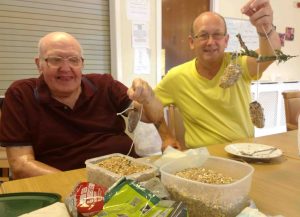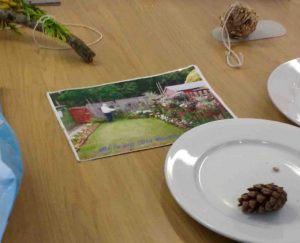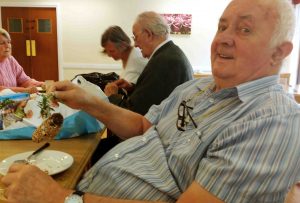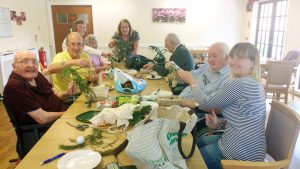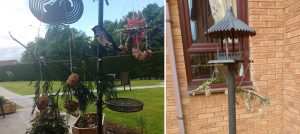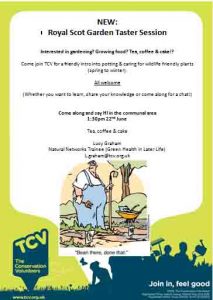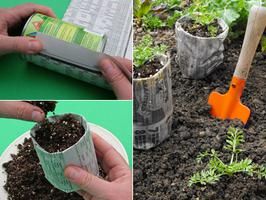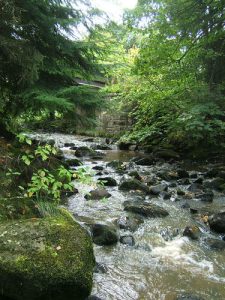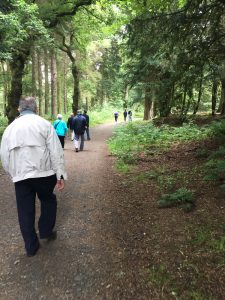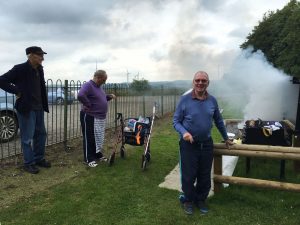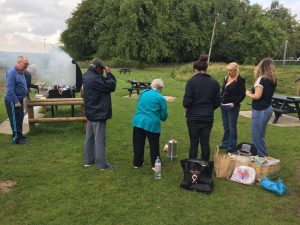
One of the best parts of the natural networks traineeship has been meeting so many open, funny and warm people in the older communities of West Lothian (even if they were a little – understandably – hesitant at first with my obsession with all things nature).
Here’s some of the green health in later life highlights:
Care homes – Bringing the outdoors indoors
You don’t have to go deep into the wilderness to bring about good memories and pride in your natural environment. In care homes, with residents living with dementia, we brought the outdoors indoors making bird feeders from twigs, leaves and pine cones.
They became the hot topic of conversation! People started chatting about old memories – red robin flashes in winter, early morning bird calls and…seagulls nicking a packet of crisps.
The bird feeders showed we all have something in common through nature, however small.
Although, one lady sat down, set eyes on the bird feed, furrowed her brows and said with conviction “I Hate birds” – It’s not everyone’s cuppa…
At the end of the day we hung up the feeders outside windows and sold the spares at the care homes’ open day – they know how to drive a hard sell…
50s environmental group – Citizen science walks
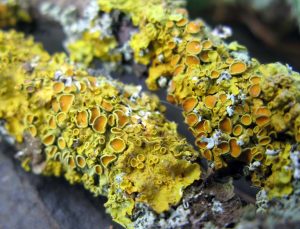 *Cue music* ♪ Do you really lichen it? We’re lovin’ it Lovin’ it, lovin’ it ♫. The 50s environmental group didn’t know what was in store for them, when, out of a massive rucksack, I pulled out big green twigs, clipboards and magnifying glasses.
*Cue music* ♪ Do you really lichen it? We’re lovin’ it Lovin’ it, lovin’ it ♫. The 50s environmental group didn’t know what was in store for them, when, out of a massive rucksack, I pulled out big green twigs, clipboards and magnifying glasses.
It was time to get an eye into the tiny world of a lichen….
Lichens (a surprising relationship between fungi and algae) grow in huge multicoloured diversity almost anywhere, but most noticeably on the bark of our trees.
We pass by these little creatures everyday yet th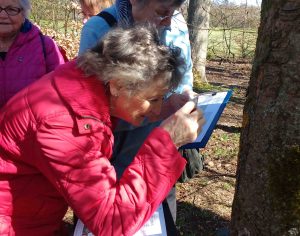 ey are indicators of our local air quality health, have survived in space and are used to make dye and perfume. Now, I did get asked “Lucy…WHY do you love lichens so much?” …”Um, I do love an underdog”.
ey are indicators of our local air quality health, have survived in space and are used to make dye and perfume. Now, I did get asked “Lucy…WHY do you love lichens so much?” …”Um, I do love an underdog”.
Yet, it wasn’t long before everyone was getting personal to the trees,with a magnifying glass in hand.
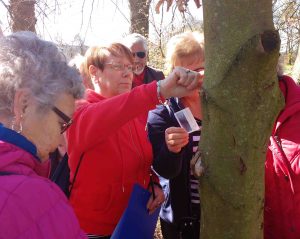 We ended the walk around Howden Park with a cup of tea and a bag load of lichen records – a surprising variety of lichens and good park air quality.
We ended the walk around Howden Park with a cup of tea and a bag load of lichen records – a surprising variety of lichens and good park air quality.
Who’d have thought you can find so much wilderness and interest in the tiniest of spaces?
Housing associations and sheltered housing – Garden sessions
In contrast to the belly laughing closeness of the 50s environmental group, who regularly spent time together outdoors, I visited less close knit in small retirement/sheltered housing. I encouraged (very!) small wildlife improvements to the gardens – bee friendly hanging baskets here, bird feeders outside the window and some potted herbs there, whilst listening to people’s stories.
This was one the tougher experiences, I met people who felt they’d been cut off from the world and other people for years. They had anxieties about making new friends, hated their concrete environment, and felt restricted by their age and physical abilities to go outside. They needed support to change their view of themselves and how they felt others will react to them. Yet, they had so much to share themselves and with each other…
With a mix of remorse and pride, one lady told back breaking tales of working 7 days a week on dad’s farm, spending all her time in tune to the seasons and the wildlife. And now, she stares at 4 walls, itching to do something. Another lady had been a horticulturalist and liked 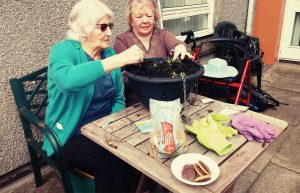 to pull my strings quizzing the latin names of plants – she had so much knowledge to share. A tenant told how he had been in hospital 3 times that week but still got outside to water the hanging baskets. 2 ladies, who’d once been strangers, planted a hanging pot together and shared childhood outdoor stories. Whizzing along the patio in a 4 wheeler mobility, a resident rallied the masses – planting, pruning and watering – while tenants stared confused. Eventually they couldn’t help but come outside and lend a hand and later entered their green creation into a competition.
to pull my strings quizzing the latin names of plants – she had so much knowledge to share. A tenant told how he had been in hospital 3 times that week but still got outside to water the hanging baskets. 2 ladies, who’d once been strangers, planted a hanging pot together and shared childhood outdoor stories. Whizzing along the patio in a 4 wheeler mobility, a resident rallied the masses – planting, pruning and watering – while tenants stared confused. Eventually they couldn’t help but come outside and lend a hand and later entered their green creation into a competition.
Only tiny, brief changes. But can’t help but think what a difference an area of nature makes to a sense of place, and the people power it takes to nurture it.
Mental health charity group – Green Gym
MOOD project is an inspiring charity who support people with/at risk of developing mental health problems aged 55+. Mood provides the support needed for people to make friends to combat isolation, loneliness and build self-esteem and confidence. You can tell by the closeness of their groups and passion.
Caroline from MOOD project approached me about setting up a green gym based around the concept of 5 ways to well (Paul’s brilliant project in Cumbernauld, see inspiring blog here). We wanted to make sure that the programme was designed in a way that would build people’s confidence to access local green-spaces and use public transport independently.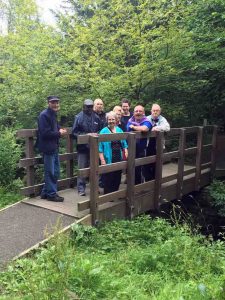
And so what better way to spend a day than at the local 68 hectare (whoa!) Polkemmet Country Park.
As an intro to Green Gym, couldn’t think of a better way to spend a day than a nature walk (with strategically placed nature questions around the woodland) followed by LOTS of food.
It didn’t matter that people had different walking abilities or different transport (a mobility scooter or a walker). Everyone came eager to contribute food, cook on the Barbie, share stories about the outdoors, ID the trees and plants, encourage others to go on the walk, have a laugh and play along with the hidden nature questions. One man had dementia and a wicked sense of humour – who suddenly stopped and point out a tree to me…”tree-mendous!”.The group, given a job to do outside, bonded to each other and responsible for each other’s cares and the trees and birds around them
“I belong outside with the trees and the birds, otherwise I would be sitting inside watching TV”
“It’s a great laugh and shows we can overcome our obstacles as long as there’s good people, food and trees!”
The Age of Loneliness
“Research has shown that experiencing loneliness for a long time is as damaging as smoking 15 cigarettes a day”
Though we may find it hard to talk about, loneliness does not just affect the older generation. Loneliness affects all of us at some point in our lives no matter our age: relocating to a new area (me for this traineeship!), losing a loved one, starting a new course at university. Our time has been called “the age of loneliness”. From care homes to moving home, there are lots of examples in our society where it is easier for people to become cut off from all human connections than ever before.
Yet, from all the stories and blogs trainees have posted over the past 9 months, its hard not to notice both the expanding green networks and people networks across the country.
People Nurture Nature & Nature Nurtures People….
To get a bit soppy (look away now), all these people taught me that no matter your situation, physical or mental health, that natural wonder and safety can be found in the smallest of wild places. And those outdoor experiences are bonding, especially when you’re going through a tough time in life.
